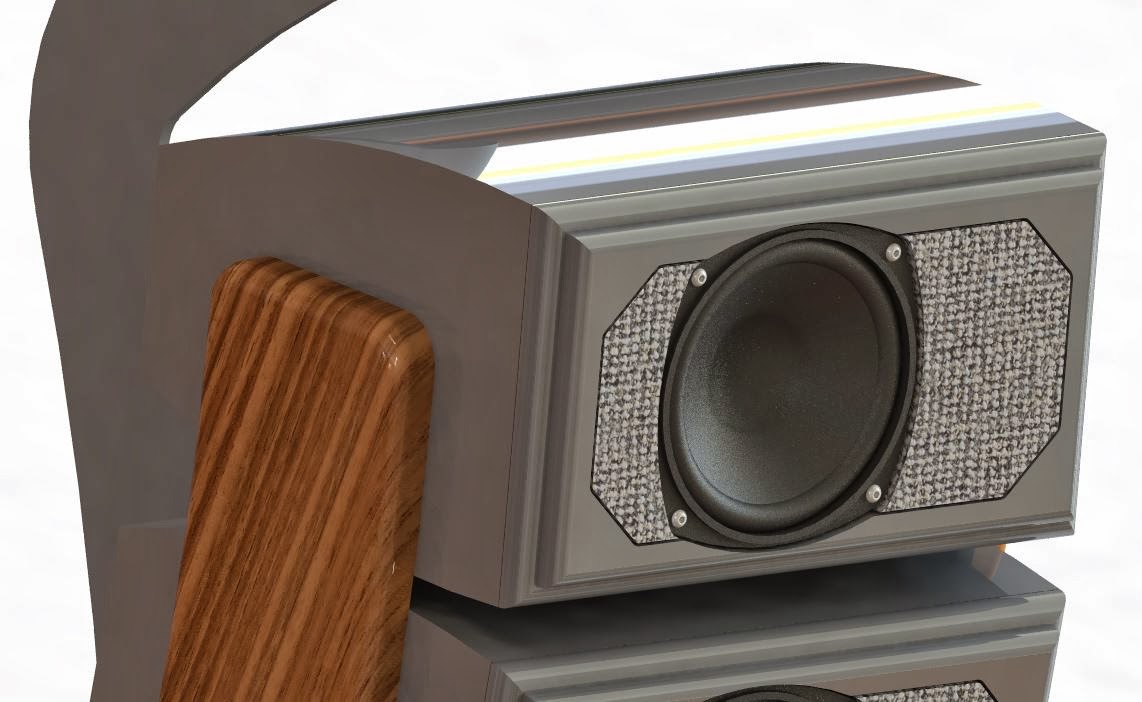I've updated my blog with my latest project, upgrading the speakers in my churche's main sanctuary.
Joseph Crowe's DIY Speaker Building Blog: Church Speaker Upgrade
Comments?
Joseph Crowe's DIY Speaker Building Blog: Church Speaker Upgrade
Comments?
are you certain a 3/8 threaded rod is going to be sufficient to hold the weight of this assembly?
other than that you seem to have worked out quite an elegant solution!!
other than that you seem to have worked out quite an elegant solution!!
Indeed.
Fatigue at the root of the thread will be a real problem.
What about a back up cable to the top of the speaker?
Fatigue at the root of the thread will be a real problem.
What about a back up cable to the top of the speaker?
Yes I think that needs to be revisited. I plan on having a lanyard safety cable in the even of failure.
Here are some further developments on my design.
Joseph Crowe's DIY Speaker Building Blog: Church Speaker Upgrade Continued....

Here are some further developments on my design.
Joseph Crowe's DIY Speaker Building Blog: Church Speaker Upgrade Continued....
Cool design. At what frequency will you cross over to the tweeters?
You mentioned the annoying little tabs on the NL4MP in your blog. I dislike those as well. In case you didn't already know, Neutrik came out with an updated version called NL4MP-UC featuring larger 1/4" terminals. (On PE.) Having used both, the UC version is a pleasure to work with.
You mentioned the annoying little tabs on the NL4MP in your blog. I dislike those as well. In case you didn't already know, Neutrik came out with an updated version called NL4MP-UC featuring larger 1/4" terminals. (On PE.) Having used both, the UC version is a pleasure to work with.
Cool design. At what frequency will you cross over to the tweeters?
You mentioned the annoying little tabs on the NL4MP in your blog. I dislike those as well. In case you didn't already know, Neutrik came out with an updated version called NL4MP-UC featuring larger 1/4" terminals. (On PE.) Having used both, the UC version is a pleasure to work with.
Thanks for the info on the NL4MP-UC! The crossover point is yet to be determined, although I think it will likely be between 2 to 3kHz. 24db/octave since it's a digital crossover.
There will be a steep 80hz high pass as well to the mid bass drivers.
With four mid bass drivers I'm looking at 101 dB sensitivity. The two HF units get me up to 109 dB.
Thanks for the info on the NL4MP-UC! The crossover point is yet to be determined, although I think it will likely be between 2 to 3kHz. 24db/octave since it's a digital crossover.
There will be a steep 80hz high pass as well to the mid bass drivers.
With four mid bass drivers I'm looking at 101 dB sensitivity. The two HF units get me up to 109 dB.
You bet! You seem to know a lot about what you are doing, what kind of feedback are you looking for?
With four mid bass drivers I'm looking at 101 dB sensitivity.
Hi,
I don't know how you work that out. Assuming 92dB and 8ohms
into half space, at low frequencies your looking at 86dB per driver
into free space, 92dB for 4 drivers series/parallel 8 ohm and
98dB for all drivers in parallel for a 2 ohm load.
It will rise towards the x/o point by 6dB, there is some argument
a 2.5 way might work better than EQing it as a 2 way speaker.
rgds, sreten.
Hi,
I don't know how you work that out. Assuming 92dB and 8ohms
into half space, at low frequencies your looking at 86dB per driver
into free space, 92dB for 4 drivers series/parallel 8 ohm and
98dB for all drivers in parallel for a 2 ohm load.
It will rise towards the x/o point by 6dB, there is some argument
a 2.5 way might work better than EQing it as a 2 way speaker.
rgds, sreten.
Good point. Likely in the bass region from 80hz to 300hz I'll be down like you say. My plan will be to EQ to correct this, now how to calculate if this will be sufficient is beyond my experience. How would I go about calculating the maximum SPL for a given size venue? Or do I simplify it by assuming half space?
Good point. Likely in the bass region from 80hz to 300hz I'll be down like you say. My plan will be to EQ to correct this, now how to calculate if this will be sufficient is beyond my experience. How would I go about calculating the maximum SPL for a given size venue? Or do I simplify it by assuming half space?
I was trying to recall why this deficiency didn't show up when I tested my MTM design and I think it's because I went with a steep 24db/octave on my speakers at 80hz (to protect them) however for the subwoofer I had it set to 6dB/octave, hence allowing the sub to fill in the natural bass reduction from 80 - 160hz with my speakers. The subwoofer did quite well, and didn't sound boomy. Gotta love 18mm Baltic Birch!
- Status
- Not open for further replies.
- Home
- Live Sound
- PA Systems
- Church speaker upgrade